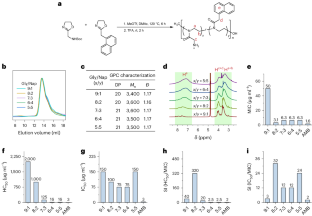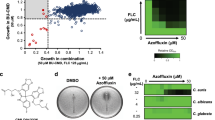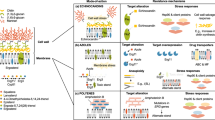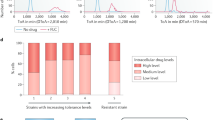Abstract
Drug-resistant fungal infections pose a significant threat to human health. Dual-targeting compounds, which have multiple targets on a single pathogen, offer an effective approach to combat drug-resistant pathogens, although ensuring potent activity and high selectivity remains a challenge. Here we propose a dual-targeting strategy for designing antifungal compounds. We incorporate DNA-binding naphthalene groups as the hydrophobic moieties into the host defence peptide-mimicking poly(2-oxazoline)s. This resulted in a compound, (Gly0.8Nap0.2)20, which targets both the fungal membrane and DNA. This compound kills clinical strains of multidrug-resistant fungi including Candida spp., Cryptococcus neoformans, Cryptococcus gattii and Aspergillus fumigatus. (Gly0.8Nap0.2)20 shows superior performance compared with amphotericin B by showing not only potent antifungal activities but also high antifungal selectivity. The compound also does not induce antimicrobial resistance. Moreover, (Gly0.8Nap0.2)20 exhibits promising in vivo therapeutic activities against drug-resistant Candida albicans in mouse models of skin abrasion, corneal infection and systemic infection. This study shows that dual-targeting antifungal compounds may be effective in combating drug-resistant fungal pathogens and mitigating fungal resistance.
This is a preview of subscription content, access via your institution
Access options
Access Nature and 54 other Nature Portfolio journals
Get Nature+, our best-value online-access subscription
$29.99 / 30 days
cancel any time
Subscribe to this journal
Receive 12 digital issues and online access to articles
$119.00 per year
only $9.92 per issue
Buy this article
- Purchase on Springer Link
- Instant access to full article PDF
Prices may be subject to local taxes which are calculated during checkout






Similar content being viewed by others
Data availability
Data supporting the findings of this study are available within the Article and Supplementary Information. Source data are provided with this paper. Any other source data perceived as pertinent are available, on reasonable request, from the corresponding author.
References
Fukushima, K. et al. Supramolecular high-aspect ratio assemblies with strong antifungal activity. Nat. Commun. 4, 2861 (2013).
Pappas, P. G., Lionakis, M. S., Arendrup, M. C., Ostrosky-Zeichner, L. & Kullberg, B. J. Invasive candidiasis. Nat. Rev. Dis. Primers 4, 18026 (2018).
Kupferschmidt, K. New drugs target growing threat of fatal fungi. Science 366, 407 (2019).
Zhang, X. et al. Development of lipo-γ-AA peptides as potent antifungal agents. J. Med. Chem. 65, 8029–8039 (2022).
Fisher, M. C., Hawkins, N. J., Sanglard, D. & Gurr, S. J. Worldwide emergence of resistance to antifungal drugs challenges human health and food security. Science 360, 739–742 (2018).
Zhang, F. et al. A marine microbiome antifungal targets urgent-threat drug-resistant fungi. Science 370, 974–978 (2020).
Fisher, M. C. et al. Tackling the emerging threat of antifungal resistance to human health. Nat. Rev. Microbiol. 20, 557–571 (2022).
Berman, J. & Krysan, D. J. Drug resistance and tolerance in fungi. Nat. Rev. Microbiol. 18, 319–331 (2020).
Iyer, K. R., Revie, N. M., Fu, C., Robbins, N. & Cowen, L. E. Treatment strategies for cryptococcal infection: challenges, advances and future outlook. Nat. Rev. Microbiol. 19, 454–466 (2021).
Lockhart, S. R., Chowdhary, A. & Gold, J. A. W. The rapid emergence of antifungal-resistant human-pathogenic fungi. Nat. Rev. Microbiol. 21, 818–832 (2023).
Day, J. N. et al. Combination antifungal therapy for cryptococcal meningitis. N. Engl. J. Med. 368, 1291–1302 (2013).
Shekhar-Guturja, T. et al. Dual action antifungal small molecule modulates multidrug efflux and TOR signaling. Nat. Chem. Biol. 12, 867–875 (2016).
Theuretzbacher, U. Dual-mechanism antibiotics. Nat. Microbiol. 5, 984–985 (2020).
Silver, L. L. Multi-targeting by monotherapeutic antibacterials. Nat. Rev. Drug Discov. 6, 41–55 (2007).
Parkes, A. L. & Yule, I. A. Hybrid antibiotics—clinical progress and novel designs. Expert Opin. Drug Discov. 11, 665–680 (2016).
Yarlagadda, V., Sarkar, P., Samaddar, S. & Haldar, J. A vancomycin derivative with a pyrophosphate-binding group: a strategy to combat vancomycin-resistant bacteria. Angew. Chem. Int. Ed. Engl. 55, 7836–7840 (2016).
Jiang, Y. et al. “Metaphilic” cell-penetrating polypeptide–vancomycin conjugate efficiently eradicates intracellular bacteria via a dual mechanism. ACS Cent. Sci. 6, 2267–2276 (2020).
Martin, J. K. et al. A dual-mechanism antibiotic kills gram-negative bacteria and avoids drug resistance. Cell 181, 1518–1532 (2020).
Bai, S. et al. A polymeric approach toward resistance-resistant antimicrobial agent with dual-selective mechanisms of action. Sci. Adv. 7, eabc9917 (2021).
Denning, D. W. & Bromley, M. J. How to bolster the antifungal pipeline. Science 347, 1414–1416 (2015).
Kuroda, K. & DeGrado, W. F. Amphiphilic polymethacrylate derivatives as antimicrobial agents. J. Am. Chem. Soc. 127, 4128–4129 (2005).
Hancock, R. E. & Sahl, H. G. Antimicrobial and host-defense peptides as new anti-infective therapeutic strategies. Nat. Biotechnol. 24, 1551–1557 (2006).
Xiong, M. et al. Helical antimicrobial polypeptides with radial amphiphilicity. Proc. Natl Acad. Sci. USA 112, 13155–13160 (2015).
Lee, E. Y. et al. Helical antimicrobial peptides assemble into protofibril scaffolds that present ordered dsDNA to TLR9. Nat. Commun. 10, 1012 (2019).
Mookherjee, N., Anderson, M. A., Haagsman, H. P. & Davidson, D. J. Antimicrobial host defence peptides: functions and clinical potential. Nat. Rev. Drug Discov. 19, 311–332 (2020).
Xian, W. et al. Histidine-mediated ion specific effects enable salt tolerance of a pore-forming marine antimicrobial peptide. Angew. Chem. Int. Ed. Engl. 61, e202108501 (2022).
Sang, P. & Cai, J. Unnatural helical peptidic foldamers as protein segment mimics. Chem. Soc. Rev. 52, 4843–4877 (2023).
Hurdle, J. G., O’Neill, A. J., Chopra, I. & Lee, R. E. Targeting bacterial membrane function: an underexploited mechanism for treating persistent infections. Nat. Rev. Microbiol. 9, 62–75 (2011).
Nederberg, F. et al. Biodegradable nanostructures with selective lysis of microbial membranes. Nat. Chem. 3, 409–414 (2011).
Krumm, C. et al. Antimicrobial poly(2-methyloxazoline)s with bioswitchable activity through satellite group modification. Angew. Chem. Int. Ed. Engl. 53, 3830–3834 (2014).
Bai, H. et al. A supramolecular antibiotic switch for antibacterial regulation. Angew. Chem. Int. Ed. Engl. 54, 13208–132013 (2015).
Lam, S. J. et al. Combating multidrug-resistant Gram-negative bacteria with structurally nanoengineered antimicrobial peptide polymers. Nat. Microbiol. 1, 16162 (2016).
Chin, W. et al. A macromolecular approach to eradicate multidrug resistant bacterial infections while mitigating drug resistance onset. Nat. Commun. 9, 917 (2018).
Zhong, W. et al. Designer broad-spectrum polyimidazolium antibiotics. Proc. Natl Acad. Sci. USA 117, 31376–31385 (2020).
Cho, Y. et al. Noncovalent interactions of DNA bases with naphthalene and graphene. J. Chem. Theory Comput. 9, 2090–2096 (2013).
Zhou, M. et al. Poly(2-oxazoline)-based functional peptide mimics: eradicating MRSA infections and persisters while alleviating antimicrobial resistance. Angew. Chem. Int. Ed. Engl. 59, 6412–6419 (2020).
Whitfield, C. J. et al. Functional DNA–polymer conjugates. Chem. Rev. 121, 11030–11084 (2021).
Rautenbach, M., Troskie, A. M. & Vosloo, J. A. Antifungal peptides: to be or not to be membrane active. Biochimie 130, 132–145 (2016).
Jiang, W. et al. Short guanidinium-functionalized poly(2-oxazoline)s displaying potent therapeutic efficacy on drug-resistant fungal infections. Angew. Chem. Int. Ed. Engl. 61, e202200778 (2022).
Dos Reis, T. F. et al. A host defense peptide mimetic, brilacidin, potentiates caspofungin antifungal activity against human pathogenic fungi. Nat. Commun. 14, 2052 (2023).
Chang, W. et al. Efflux pump-mediated resistance to antifungal compounds can be prevented by conjugation with triphenylphosphonium cation. Nat. Commun. 9, 5102 (2018).
Acknowledgements
This study was supported by the National Natural Science Foundation of China (number T2325010 (R.L.)), National Key Research and Development Program of China (2022YFC2303100 (R.L.)), National Natural Science Foundation of China (22075078 (R.L.), 22305082 (M.Z.), 52203162 (Y.W.), 82370005 (X.X.)), Shanghai Frontiers Science Center of Optogenetic Techniques for Cell Metabolism (Shanghai Municipal Education Commission) (R.L.), Open Research Fund of State Key Laboratory of Polymer Physics and Chemistry (Changchun Institute of Applied Chemistry, Chinese Academy of Sciences) (R.L.) and the Open Project of Engineering Research Center of Dairy Quality and Safety Control Technology (Ministry of Education, R202201) (R.L.). We thank the Analysis and Testing Center of the East China University of Science and Technology for their help in the characterization. We also thank the Analysis and Testing Center of the School of Chemical Engineering, East China University of Science and Technology for the support. We thank the staff members of the Integrated Laser Microscopy System at the National Facility for Protein Science in Shanghai (NFPS), Zhangjiang Lab, China, for providing technical support and assistance in data collection and analysis.
Author information
Authors and Affiliations
Contributions
M.Z. and R.L. conceived the idea, proposed the strategy, designed the experiments, evaluated the data and wrote the paper together. M.Z. performed majority of the experiments. L.L., Z.C. and Z.L. contributed to the in vivo animal models. W.J., X.X. and S.C. participated in the confocal microscopy study. J.X. performed the SEM test. Y.W. contributed to the data analysis and result discussion. N.S. contributed to the cytotoxicity assay. X.X. contributed to the antifungal activity test on Cryptococcus gatti. All authors proofread the paper.
Corresponding author
Ethics declarations
Competing interests
R.L. and M.Z. are co-inventors of a patent application covering the reported synthesis of poly(2-oxazoline)s and their antifungal application. The other authors declare no competing interests.
Peer review
Peer review information
Nature Microbiology thanks Dominique Sanglard, Shu Wang and the other, anonymous, reviewer(s) for their contribution to the peer review of this work.
Additional information
Publisher’s note Springer Nature remains neutral with regard to jurisdictional claims in published maps and institutional affiliations.
Extended data
Extended Data Fig. 1 Design and performance of dual-targeting antifungal HDP-mimicking poly(2-oxazoline)s.
(a) Design of dual-targeting HDP-mimicking poly(2-oxzoline)s bearing amphiphilic structure for membrane targeting and naphthalene group for DNA binding. (b) Schematic diagram of dual-targeting and dual-mechanism antifungal poly(2-oxzoline)s targeting both fungal cell membrane and DNA. (c) Potent therapeutic effect of the optimal antifungal poly(2-oxzoline) in treating mice drug-resistant fungal infections as demonstrated using multiple animal models.
Extended Data Fig. 2 Fungicidal efficiency of (Gly0.8Nap0.2)20 and corresponding PI staining of fungi.
(a) The percentage of killed Candida albicans K1 treated with (Gly0.8Nap0.2)20 at 1×MFC concentration, with an initial concentration of 1×106 CFU/mL in RPMI 1640 medium. n = 3 independent samples. Data are presented as mean values ± SD. (b-f) Confocal images and the corresponding percentage of PI staining of (Gly0.8Nap0.2)20-treated Candida albicans K1 at variable time points, with an initial fungal concentration of 1×106 CFU/mL in RPMI 1640 medium. The confocal imaging was collected once, at least 50 fungal cells were observed individually in the sample displaying results similar to the representative images as shown in this figure.
Extended Data Fig. 3 Influence of exogenous fungal membrane lipid components on the antifungal activity of (Gly0.8Nap0.2)20.
Change of (Gly0.8Nap0.2)20’s antifungal activity in the presence of exogenous fungal membrane lipid components (a) phosphatidylglycerol (PG) and (b) phosphatidylinositol (PI), respectively, using terbinafine for comparison.
Extended Data Fig. 4 Influence of intracellular ROS on the antifungal activity of (Gly0.8Nap0.2)20.
(a) Intracellular ROS intensity of Candida albicans K1 in the presence of PBS, polymer and the mixture of polymer and NAC (10 mM). n = 3 independent samples. Data are presented as mean values ± SD. (b) MIC value of polymer against Candida albicans K1 in the presence or absence of NAC.
Extended Data Fig. 5 Influence of protease, inorganic salt ions and serum on the antifungal activity of (Gly0.8Nap0.2)20.
(a) The MIC values for (Gly0.8Nap0.2)20 against Candida albicans K1 in the presence of pepsin, papain, trypsin and proteinase K at a concentration of 10 mg/mL, respectively. The changes in MIC values of (Gly0.8Nap0.2)20 in the presence of calcium ion (b), magnesium ion (c) and 5% fetal bovine serum (d), using melittin as the control.
Extended Data Fig. 6 In vivo distribution of (Gly0.8Nap0.2)20.
The concentration of (Gly0.8Nap0.2)20 in the heart (a), liver (b), spleen (c), lung (d) and kidney (e) of mice at various time points, respectively, using dye-labeled (Gly0.8Nap0.2)20. n = 3 biologically independent animals. Data are presented as mean values ± SD.
Supplementary information
Supplementary Information
Materials, instrumentation and Supplementary Figs. 1–6.
Supplementary Table 1 and Supplementary Table 2
Antifungal activities and selectivity index of the optimal (Gly0.8Nap0.2)20 against drug-resistant fungi. Drug sensitivity information on the clinically isolated drug-resistant strains.
Source data
Source Data Fig. 1
GPC data for Fig. 1b and unprocessed NMR data for Fig. 1d.
Source Data Fig. 2
Fluorescence distribution curve of dye–(Gly0.8Nap0.2)20 and PI for Fig. 2b–d; surface zeta potential of Candida albicans K1 cells for Fig. 2e; fungal cell wall disturbance for Fig. 2f and cytoplasmic membrane depolarization of dye–(Gly0.8Nap0.2)20 for Fig. 2g; change in the antifungal activity of (Gly0.8Nap0.2)20 in the presence of phosphatidylcholine for Fig. 2h and phosphatidylethanolamine for Fig. 2i.
Source Data Fig. 3
Fluorescence intensity profiles of dye-(Gly0.8Nap0.2)20 and PI for Fig. 3b,c; DLS analysis for Fig. 3d; fluorescence quenching of the DNA–dye complex by the addition of (Gly0.8Nap0.2)20 for Fig. 3e; ultraviolet spectra for Fig. 3f and CD spectra for Fig. 3g of DNA before and after (Gly0.8Nap0.2)20 treatment; zeta potential of nontreated and (Gly0.8Nap0.2)20-treated DNA for Fig. 3h; antifungal activity of (Gly0.8Nap0.2)20 for Fig. 3i.
Source Data Fig. 4
Fluorescence intensity changes of DAPI and MitoTracker Red for Fig. 4d; drug resistance test results for Fig. 4e; change of MIC values for antifungal drugs against (Gly0.8Nap0.2)20-treated Candida albicans RK2911 and FLC-treated Candida albicans RK2911 for Fig. 4f; change of MIC values for (Gly0.8Nap0.2)20 against Candida albicans K1 in the presence of trypsin for Fig. 4g.
Source Data Fig. 5
The fungal cell burden in the infected eyeballs for Fig. 5b; clinical scores for keratitis after treatment for Fig. 5d; the fungal cell burden (log10(CFU g−1)) in the infected skin for Fig. 5g.
Source Data Fig. 6
Survival rate of mouse with invasive fungal infection for Fig. 6b; fungal cell burden (log10(CFU g−1)) in different organs of mice for Fig. 6c; changes in uninfected mouse body weight after (Gly0.8Nap0.2)20 treatment for Fig. 6e; serum biochemistry analysis on uninfected mouse for Fig. 6g.
Source Data Extended Data Fig. 2
The percentage of killed Candida albicans K1 treated with (Gly0.8Nap0.2)20 for Extended Data Fig. 2a.
Source Data Extended Data Fig. 3
Change in the antifungal activity of (Gly0.8Nap0.2)20 in the presence of exogenous fungal membrane lipid components phosphatidylglycerol (PG) for Extended Data Fig. 3a and phosphatidylinositol (PI) for Extended Data Fig. 3b.
Source Data Extended Data Fig. 4
Intracellular ROS intensity of Candida albicans K1 for Extended Data Fig. 4a. MIC value of polymer against Candida albicans K1 in the presence or absence of NAC for Extended Data Fig. 4b.
Source Data Extended Data Fig. 5
The MIC values for (Gly0.8Nap0.2)20 against Candida albicans K1 in the presence of pepsin, papain, trypsin and proteinase K for Extended Data Fig. 5a. The changes in MIC values of (Gly0.8Nap0.2)20 in the presence of calcium ion for Extended Data Fig. 5b, magnesium ion for Extended Data Fig. 5c and 5% fetal bovine serum for Extended Data Fig. 5d.
Source Data Extended Data Fig. 6
The concentration of (Gly0.8Nap0.2)20 in mice heart for Extended Data Fig. 6a, liver for Extended Data Fig. 6b, spleen for Extended Data Fig. 6c, lung for Extended Data Fig. 6d and kidney for Extended Data Fig. 6e.
Rights and permissions
Springer Nature or its licensor (e.g. a society or other partner) holds exclusive rights to this article under a publishing agreement with the author(s) or other rightsholder(s); author self-archiving of the accepted manuscript version of this article is solely governed by the terms of such publishing agreement and applicable law.
About this article
Cite this article
Zhou, M., Liu, L., Cong, Z. et al. A dual-targeting antifungal is effective against multidrug-resistant human fungal pathogens. Nat Microbiol (2024). https://doi.org/10.1038/s41564-024-01662-5
Received:
Accepted:
Published:
DOI: https://doi.org/10.1038/s41564-024-01662-5



